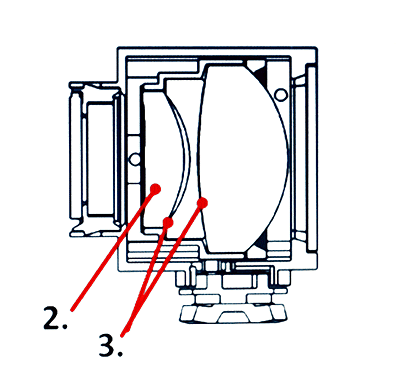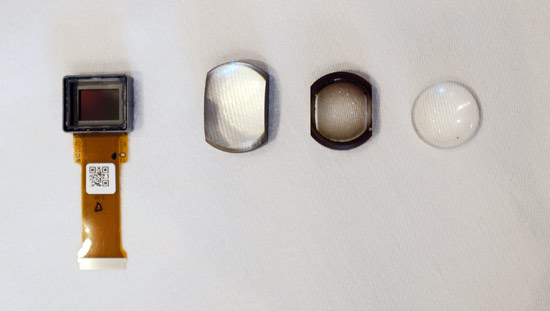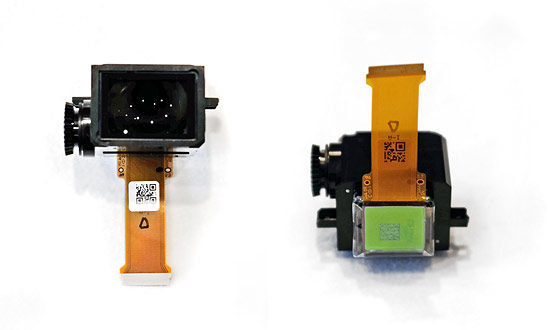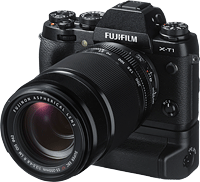What makes the Fuji X-T1 so special? Here’s what its designers think…
posted Wednesday, March 19, 2014 at 4:42 PM EDT

Fujifilm CP+ Interview: Fujifilm's key goals for the X-T1
While at the CP+ show last month, I had a chance to spend some time with engineers and product planners from Fujifilm. Our conversation covered a wide range of topics, many of which I'll write up as separate articles. A fair bit of our time together was occupied with a presentation they gave me about some of the unique technology in their new X-T1 camera. It's often interesting to hear what product engineers focus their energies on, and how a manufacturer decides to allocate the cost budget for a camera; there's always competitive price pressure, so decisions to invest more in particular aspects of a camera's operation have real consequences out in the market.
Of course, any presentation like this is bound to be strong on high points, rather than any frank assessment of a product's capabilities, but there were nonetheless a number of points that I thought would be interesting to our readers, so I'll share some of them here. There were five primary points the engineers and product planners wanted to call attention to: The X-T1's quiet operation, exceptional EVF, operating speed, weather resistance and WiFi connectivity. Let's take a look at each in turn:
Quiet Operation
While you'd think that the lack of a mirror slapping up and down would mean that all mirrorless cameras would be fairly quiet when operating, there's actually quite a wide range of variation, and the X-T1 is one of the quieter models on the market. The Fujifilm folks showed me some really interesting photos, shot of a baby fur seal by two photographers, one using an X-T1, the other a conventional SLR. I unfortunately can't share the photos with you, because Fuji didn't have a rights release that would let IR publish them as well. The interesting element in these shots was that the photographer using the X-T1 was able to get very close-up photos, with the baby seal facing the camera directly, while all the shots from the photographer using the conventional DSLR were from the side, with the seal looking away. It seemed that the sounds of the conventional SLR made the baby seal nervous, so it wouldn't face the camera/photographer. The X-T1 was so quiet that it wasn't as threatening to the young animal.
Most of the time (in the type of photography I'm most likely to do, at least), noise made by a camera is pretty much a non-issue. I'd previously thought of camera noise as perhaps being a concern in candid photography in quiet surroundings, but it hadn't occurred to me to consider how it might impact wildlife photography, mainly because I don't do any of that personally. It's a shame that I can't share any of the seal photos with you, because they made the point pretty dramatically. If quiet operation is a concern, the Fuji X-T1 is a camera you may want to consider.
Exceptional EVF optics and response time
There's no question that the Fuji X-T1's extraordinary viewfinder is one of its standout features. It's not only very high-resolution, with 2.36 million dots, but is an OLED design for better color and black levels and has a remarkable 5 millisecond lag relative to real-time. The really huge news (literally) is just how big the field of view is when looking through it. It has a magnification factor of 0.77x and a 31 degree internal angle of view. How big is that? Compare it the viewfinder on the Sony A99, a full-frame camera noted for having a nice, big display. The A99's magnification factor is 0.71x, and its internal field of view is 31.9 degrees. Turning to other manufacturers,the Canon 6D has a magnification factor of 0.71x and a 33.3 degree angle of view, the Canon 1Dx 0.75x and 35 degrees, and high-end Nikon SLRs (D800, D4S) have a magnification factor of 0.7x (Nikon doesn't seem to specify angular field of view). The X-T1's viewfinder also has nice, high eyepoint of 23mm, compared to 22mm for the Sony A99, 17mm for the Nikon D800, 18mm for the D4s, 21mm for the Canon 6D, and 20mm for the 1Dx. When it comes to dioptric correction (to allow eyeglass wearers to see a sharp image without their glasses, the -4 to +2 range of the X-T1's finder is bettered only by the Sony A99's -4 to +3 range; the Canon and Nikon models only cover from -3 to +1.
When we first looked through the Fuji X-T1's viewfinder, we were flat-out amazed at how big and roomy it seemed. Were it not for the modest-sized body we were holding, we'd have thought we were using a full-frame SLR. The stats above back this up; its magnification factor and angular field of view are right in line with many full-frame cameras, and its 23mm eyepoint is higher than pretty much any of them, good news for eyeglass wearers.
Beside offering a big view, the X-T1's viewfinder is also remarkably sharp and free of distortion, coma, chromatic aberration and other optical artifacts, a testament to the very sophisticated optics Fujifilm built into it. Viewfinder optics actually have a pretty tough assignment to fill, needing to provide a very wide angle of view at very close range, while keeping a reasonable-sized "sweet spot, so your eye won't be restricted to one tiny, very specific location for proper viewing. With constant price pressure from competitors, few camera companies invest much in viewfinder optics. After all, the viewfinder doesn't affect the quality of the final image, and as long as the user can more or less see, well enough to frame the subject, all's good, right?
It may be true that the viewfinder optics don't have anything to do with final image quality, but great VF optics vs lousy ones make an enormous difference in how pleasant a camera is to use, and being able to see the entire frame clearly and without distortion can be critical when you're dealing with tight framing. The X-T1 wins big on this score, and it's interesting to see the lengths Fujifilm went to, to deliver such a great VF experience.

(Image courtesy Fujifilm, Inc.)
Ultimately, the story of the X-T1's viewfinder comes down to optics. The screenshot above shows the 3-element optical formula of the X-T1's viewfinder, notable not only for the number of elements, but the degree of curvature of some of them. What you can't see by looking is that all three elements are made of special high refractive index glass to reduce chromatic aberration, and to be able to pack so much magnification into such a small space. (Refractive index is a measure of how sharply a lens can "bend" light rays. High refractive index glass can bend the light a lot more than normal glass, so it's helpful in creating a large magnification ratio in a small volume.)
There are also multiple aspheric surfaces involved; the leftmost element in the diagram above (the one closest to your eye) has two molded aspheric surfaces, to minimize coma aberration and geometric distortion. Coma aberration is the tendency for off-axis points to be imaged as comet-shaped streaks (hence the name). This is a very common failing in viewfinder optics, you'll probably notice it the next time you look through your own camera's viewfinder at objects in the corners of the frame. Besides helping with coma and distortion, aspheric optics also help with curvature of field, so the corners of the viewfinder image will be in focus when the center is. Good flatness of field in the viewfinder optics is obviously important if you're relying on the viewfinder to make broad judgments about what parts of the frame are in focus.
Of course, nothing comes for free, and both high-index glass and (even more so) aspheric lenses are expensive to manufacture, meaning that Fujifilm had to make a clear business decision to make the investment, hoping that users would value the results enough to pay the incremental cost involved.
One point that the Fujifilm engineers emphasized was a little obscure to me - they seemed to attach a lot of importance to the fact that the three glass elements in the X-T1's viewfinder optics touch each other directly. Apparently it's easier and more common to have the lens elements mount individually into the lens barrel or, in this case, viewfinder housing. From what I know of lens manufacture, this is relatively straightforward, because "centering" is a standard part of the lens grinding and polishing process. Centering is a grinding operation that precisely machines the outside edge of the lens so the optical center is exactly aligned with the physical center, and can be accomplished with a high degree of precision fairly easily.
It wasn't entirely clear to me, but I gathered that designing the VF optics such that the three lens elements actually touched each other was key to being able to achieve the high 0.77X magnification factor and wide 31 degree angle of view that are such key parameters.

The photo above shows the four pieces making up the guts of the X-T1's viewfinder assembly; the OLED screen attached to its flex-circuit, and the three optical elements. Even in this straight-on view, the extreme curvature of the front-most element (on the left) is obvious.

Here's a shot of the assembled viewfinder unit, as it would be mounted in a camera. Amazing that there's so much optical and electronic technology packed into such a small space.
Besides its stellar optical chops, the other very noticeable characteristic of the X-T1's viewfinder is how fast it is. Looking through it while panning the camera around or following a moving subject, there's very little visible lag, one of the bugaboos of electronic viewfinders.
I'm a little puzzled by the lag specification for the X-T1's viewfinder, which Fujifilm states as only 5 milliseconds (0.005 second). On the one hand, it makes sense from the standpoint that data could be transferred from the image sensor to the viewfinder display that quickly, but at the same time, it takes a good bit more than that long to refresh the display, reading out the image from top to bottom. The engineers briefing me gave the maximum EVF frame rate as 54 frames/second, although under lower light conditions, the refresh rate will naturally drop, as the sensor needs a longer exposure to produce a usable image.
So how do you reconcile a lag specification of 5ms with a refresh interval that would be more than three times longer than that, at the very fastest? I think the answer is that the 5ms figure refers to the delay from capturing data from each row of sensor pixels to that row being transferred to the EVF display. This means you'll see a viewfinder image that's updated at whatever the refresh rate is, with the whole image delayed 5ms from real-time as it's being "painted" by the OLED. (Our sample of the X-T1 is in Hong Kong with one of our editors right now; when it gets back to IRHQ, I'm planning a little electro-optical jiggery-pokery to verify the 5ms figure, and understand better how it relates to the update rate.)
Regardless of just how the EVF lag rating is determined, it was immediately clear that the X-T1's viewfinder was very responsive, the first time we looked through it. As noted, stay tuned; we'll have more detail on this in our ultimate X-T1 review, in the fullness of time.
Operating speed
Another key objective of the X-T1 engineering team was operating speed; not only the responsiveness of the viewfinder, but shutter lag, AF speed, predictive AF, shot to shot speed, and very fast writing to the memory card.
Shutter lag when the lens is prefocused (eg, from half-press to full-press of the shutter button is blazingly fast, at just 50 msec (confirmed by our lab tests, which came in at an average of 52 msec). AF speed is specified at just 80 msec, but we need to double-check that number at IRHQ when our sample comes back from Hong Kong with editor Mike Tomkins, as our initial AF times came in a fair bit longer than that. (Our numbers were obtained with the 35mm f/1.4 lens attached, Fujifilm's official numbers were apparently obtained with the 14mm optic. Please reserve judgment in this area until we can re-run these lab tests; the camera has generally seemed pretty responsive in real-world use to date.) Single-frame shot to shot speed is specified at 0.5 seconds, a bit faster than we measured, but we found that it was indeed very fast when writing its buffer memory to a UHS-II SD card; it dumped 23 RAW files to the card in just 8 seconds. Fujifilm also says that the the X-T1 is capable of maintaining AF tracking while shooting continuously at 8 frames/second, another claim that we'll need to test explicitly. (For what it's worth, the Fujifilm folks showed me some samples of continuous bursts with a person running directly towards the camera that showed excellent focus tracking.)
The UHS-II spec for SD cards is a relatively new one, promising significantly higher transfer rates than the already-speedy UHS-I spec; the UHS-I spec tops out at a maximum of 104 MB/s, while UHS-II allows for transfer rates as high as 312 MB/s. Currently, only Toshiba offers UHS-II SD cards, under their Exceria brand name, although SanDisk has said they'll begin selling UHS-II cards in the US later this Spring. The thing is, the current generation of Exceria cards from Toshiba top-out at sequential write speeds of just 90 MB/sec, the same speed as SanDisk's highest-end UHS-I cards are capable of. This leaves us wondering whether the X-T1 could actually copy data to the memory card even faster, once faster cards become available.
Weather resistance
Fujifilm's X-series customers apparently have been asking for weather resistance for some time now, so that capability was a key goal of the X-T1 engineers. It's splash-resistant, dust-resistance, and specified to operate in temperatures as low as -10C (14 degrees F).
Something I found interesting was that several lenses that were announced earlier on Fujifilm's X-mount roadmap (the XF18-135mmF3.5-5.6 R OIS WR, the XF16-55mmF2.8 R OIS WR and the XF50-140mmF2.8 R OIS WR) were actually weather-resistant, but that fact wasn't disclosed when they were first announced. The Fujifilm executives said that they wanted to announce the lenses when they did, but didn't want to tip their hands about an upcoming weather-resistant camera body, so they kept the weather-resistant aspect of the lenses quiet, until the X-T1 was finally announced itself.
"Productive remote photography"
These days, WiFi connectivity is pretty much a must for cameras, but there's a lot of variation in how much of a camera's functioning you can actually control, how useful the live view is that's shown on your smart device or computer, etc.
More than just providing basic connectivity, though,the mantra of the X-T1 design team was "productive remote photography." That is, they wanted to deliver a system that would be truly practical for shooting via remote control. As a result, the Fuji X-T1 gives you a much broader range of remote control over it than with many of its competitors, and the remote viewfinder's live view display is quite responsive. When the Fujifilm team demonstrated a phone/camera connection for me, the whole experience was surprisingly quick-footed; establishing the connection between phone and camera was quite fast, the remote viewfinder refresh rate was indeed pretty quick, and image transfers were very fast as well. (By default, Fujifilm's Camera Remote app transfers 3 megapixel versions of the images, more than enough for online sharing. You can also choose to transfer full-resolution versions as well, though.) Touch focus and touch shutter via the phone's screen also seemed to work very well.
We'll obviously take a deeper look at the X-T1's connectivity as part of our review, but what I saw in the brief demo at the CP+ show was very encouraging.
Summary
So that's what Fujifilm themselves consider most significant about the X-T1. As you can tell from my writeup, I personally found the technology that went into the viewfinder the most impressive, but stay tuned as we update our Fuji X-T1 review, for more details on viewfinder performance, AF speed, and connectivity. (Meanwhile, Editor Mike Tomkins is actively shooting with it in Hong Kong, so ask any questions about its operation or handling you might like to have answered. He's a good few time zones away from us at the moment, but he'll monitor any questions left below, and answer them as he's able.)
